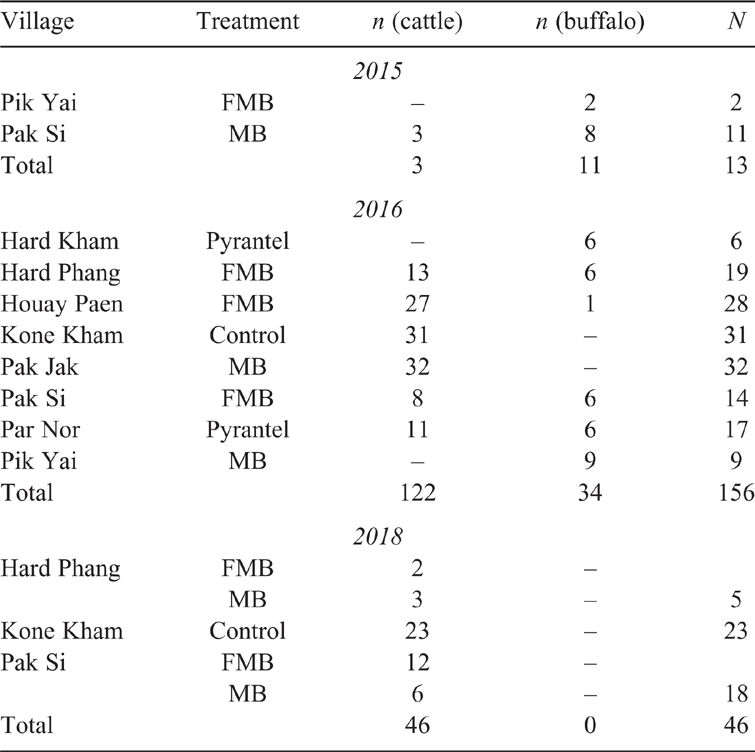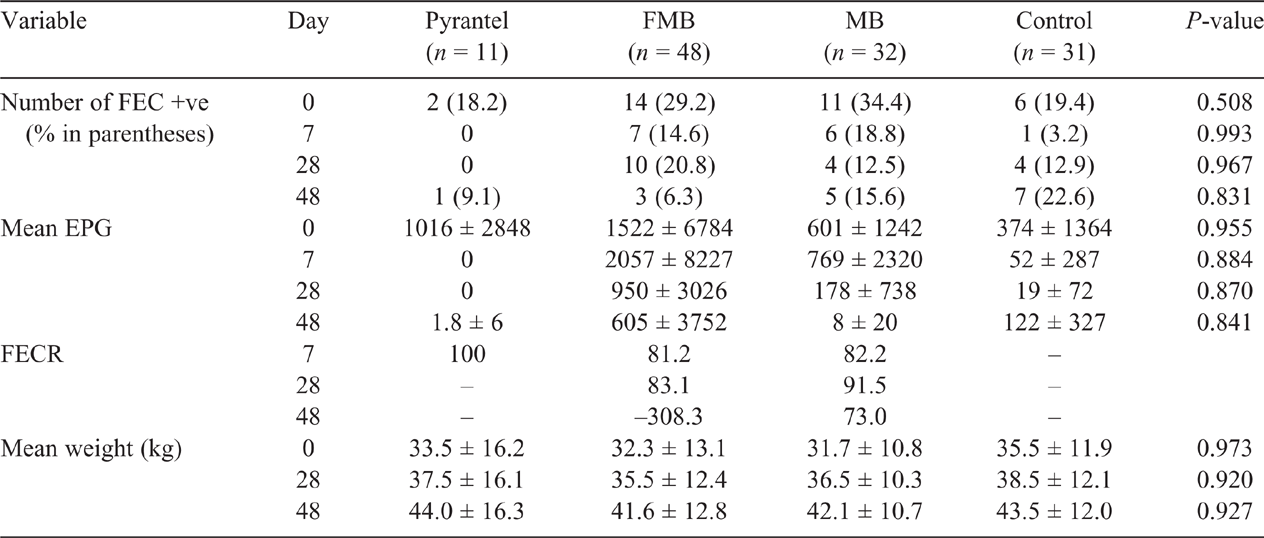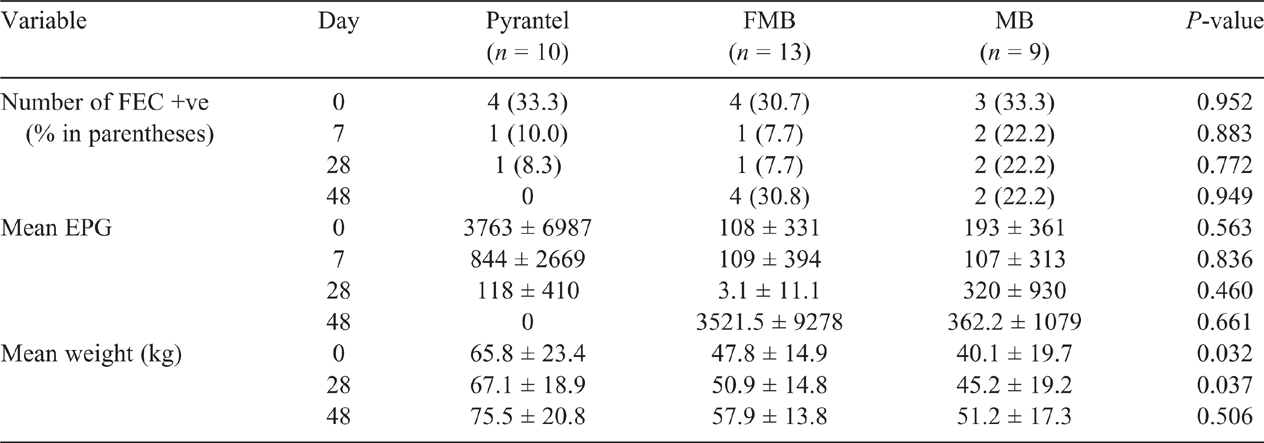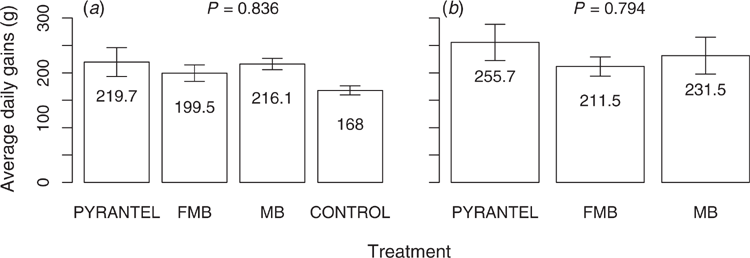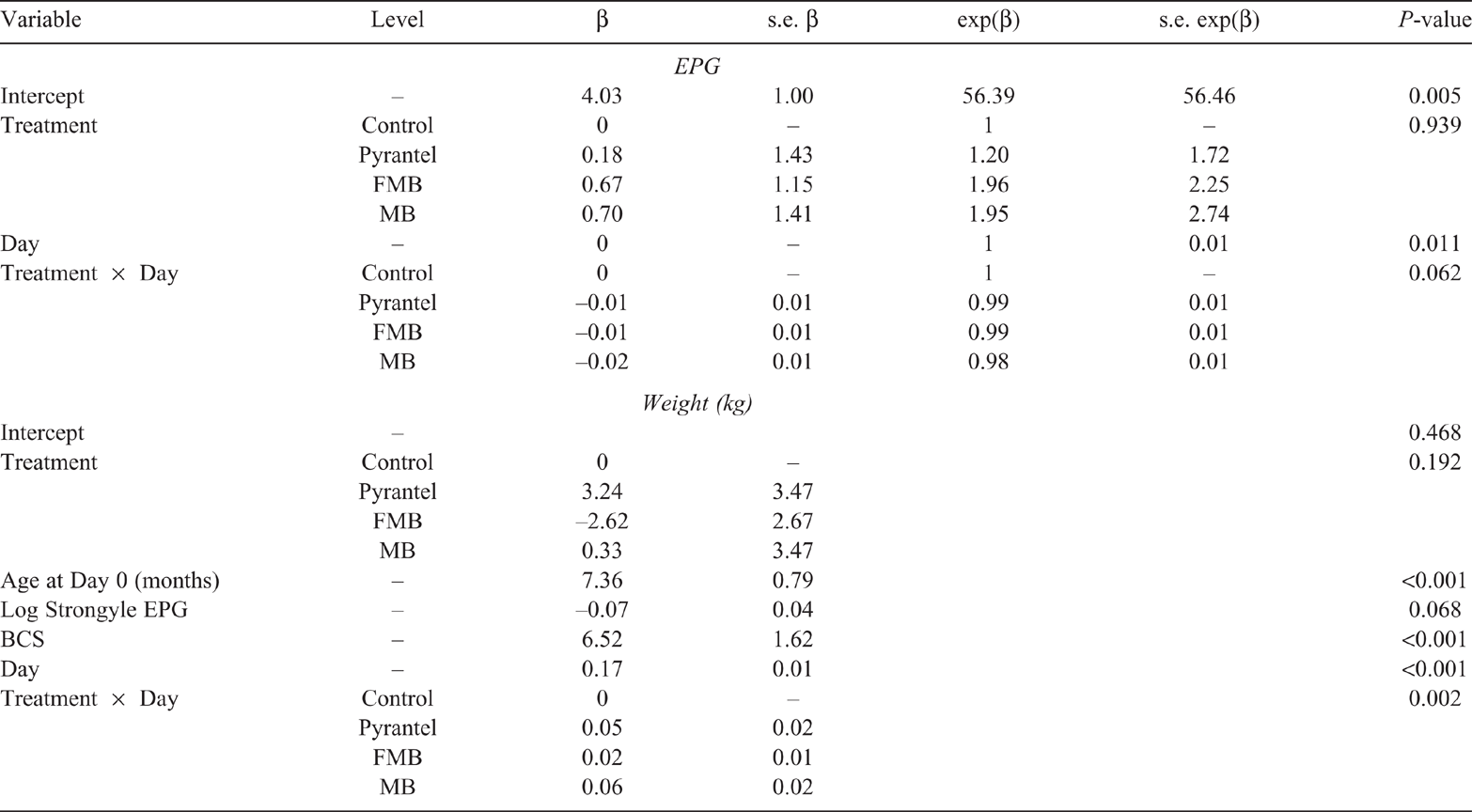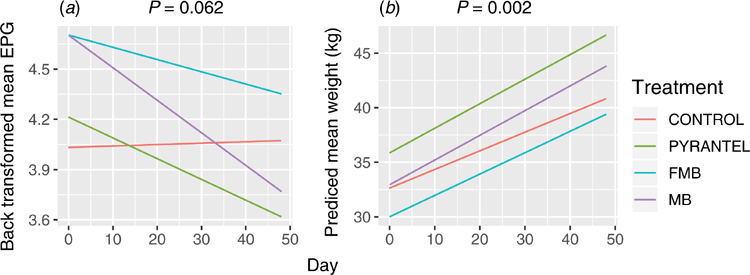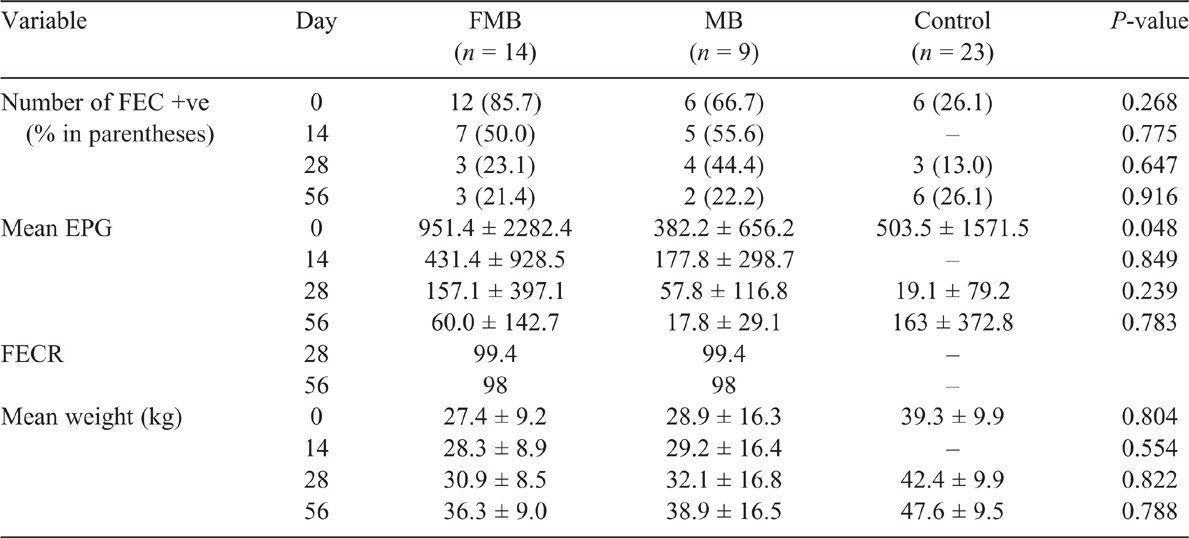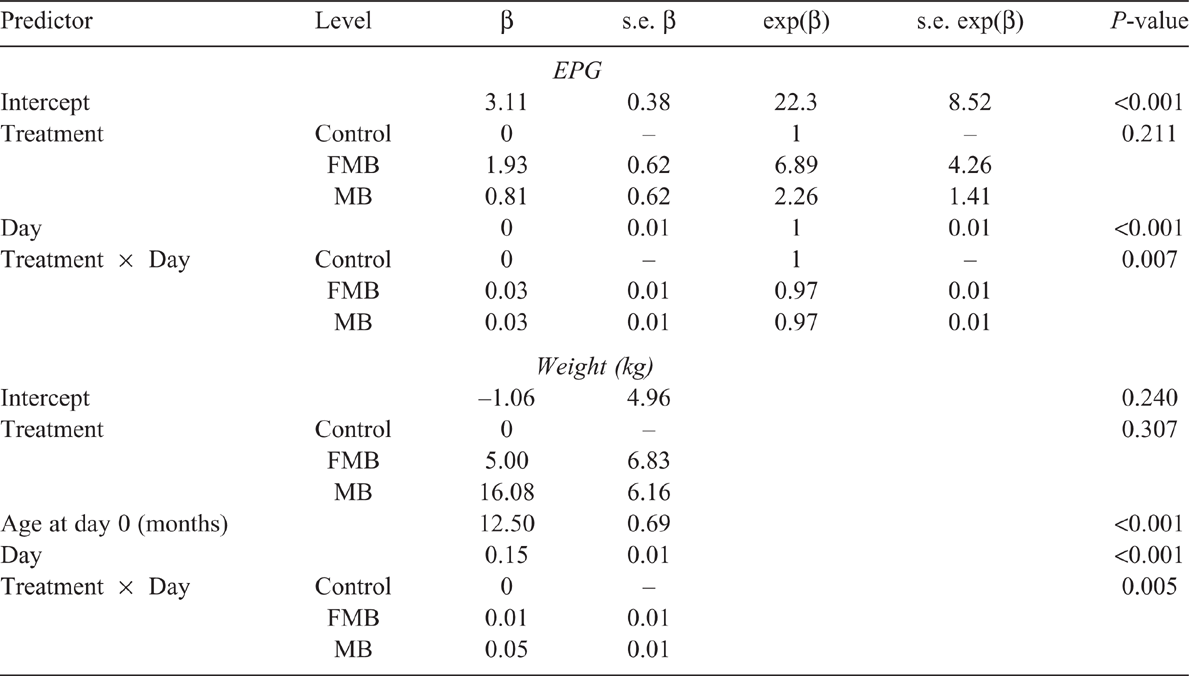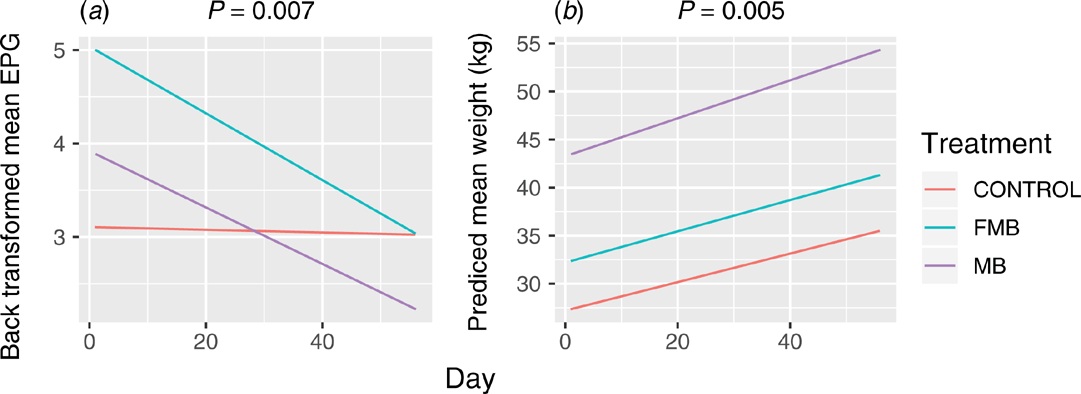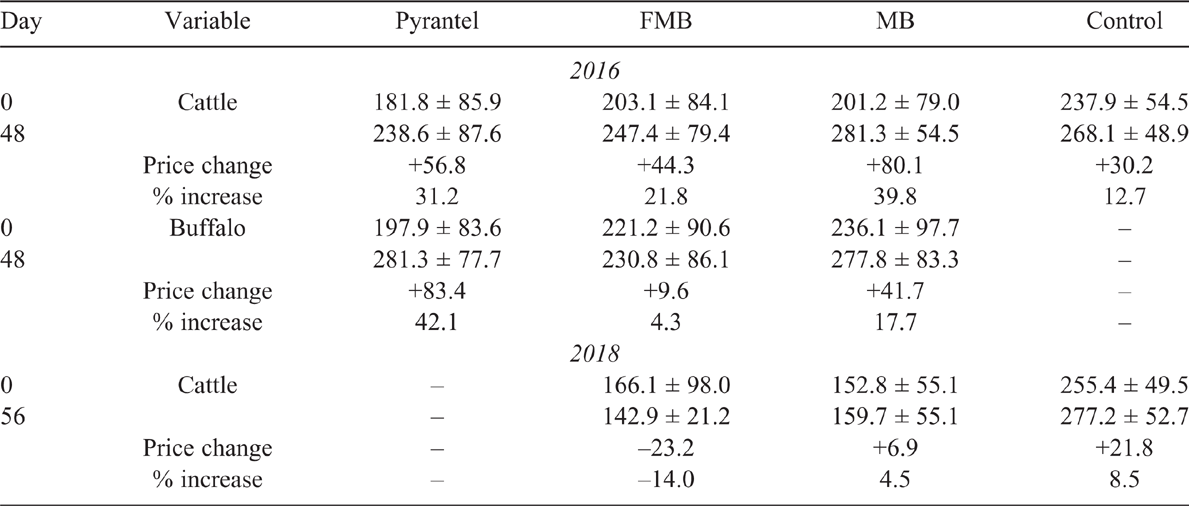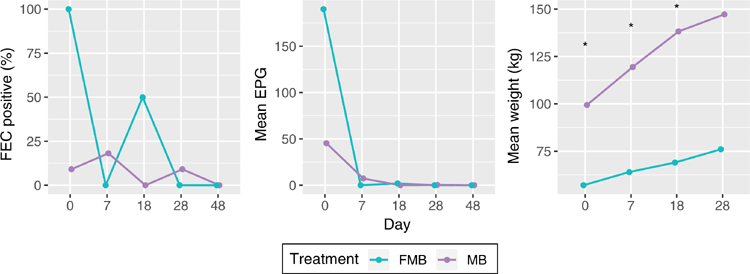Can fenbendazole-medicated molasses blocks control Toxocara vitulorum in smallholder cattle and buffalo calves in developing countries? Studies from upland Lao PDR
L. Olmo A D , S. Nampanya A B , T. S. Nemanic A , N. Selwood A , S. Khounsy B , J. R. Young A , P. C. Thomson C , R. D. Bush A and P. A. Windsor A
A D , S. Nampanya A B , T. S. Nemanic A , N. Selwood A , S. Khounsy B , J. R. Young A , P. C. Thomson C , R. D. Bush A and P. A. Windsor A
A Sydney School of Veterinary Science, The University of Sydney, Camden, NSW, 2570, Australia.
B Department of Livestock and Fisheries, Vientiane, Lao PDR.
C School of Life and Environmental Sciences, The University of Sydney, Camden, NSW, 2570, Australia.
D Corresponding author. Email: luisa.olmo@sydney.edu.au
Animal Production Science 60(17) 2031-2043 https://doi.org/10.1071/AN19248
Submitted: 27 April 2019 Accepted: 20 June 2020 Published: 29 July 2020
Journal Compilation © CSIRO 2020 Open Access CC BY
Abstract
Context: Anthelmintic treatments are not widely adopted by smallholder farmers in Laos (Lao People’s Democratic Republic) to treat bovid Toxocara vitulorum, resulting in high calf morbidity and mortality.
Aims: Field trials were conducted to provide baseline efficacy data on an alternative, easy-to-use treatment by provision of fenbendazole-medicated molasses blocks (FMB) in situ.
Methods: Participating villages were randomly allocated to the following treatments: (1) conventional orally administered pyrantel, (2) access to FMB, (3) access to non-medicated molasses blocks (MB), and (4) no blocks (control). Faecal eggs per gram (EPG) and weight were monitored in cattle (n = 171) and buffalo calves (n = 44) under field conditions for 48–56 days.
Key results: In 2016, the MB treatment was associated with the fastest reduction in predicted average EPG at 2% per day, while FMB and pyrantel had an equivalent reduction of 1% per day, relative to the control (P = 0.062). Predicted average weight also differed significantly among treatments, with pyrantel and MB having the greatest average daily gain at 230 g and FMB at 200 g, which was higher than for control calves at 170 g (P = 0.002). In buffalo calves, treatment was not significantly associated with EPG or weight. The 2018 trial corroborated that FMB and MB treatments were associated with increased EPG reductions in cattle at 3% per day, relative to control calves (P = 0.007). Again, the MB treatment had the greatest predicted average daily gain at 200 g, compared with FMB calves at 160 g and control calves at 150 g (P = 0.005).
Conclusions: The field trials provided baseline evidence that FMB and MB have potential applications in reducing environmental contamination of T. vitulorum eggs and may improve calf growth in low-input systems. However, further testing ex situ is required to control for variability in calf weight and T. vitulorum burdens, so as to optimise anthelmintic doses, assess the addition of urea to the block formula and assess product marketability.
Implications: If successful, medicated nutrient blocks may be a simple method to reduce calf mortality and morbidity, enhancing the reproductive efficiency of large ruminant production in smallholder farms in developing countries.
Additional keywords: agricultural development, intestinal parasites, large ruminants, Southeast Asia.
Introduction
In Laos (Lao People’s Democratic Republic), cattle and buffalo are predominantly produced by smallholder farmers in traditional low-input subsistence systems (Stür et al. 2002). Reproductive efficiency is low, with cattle and buffalo on average producing only one calf every 15 months and 20 months respectively (Nampanya et al. 2014b). Calf survival is poor, with annual calf morbidity of 42.6% and calf mortality of 37.3% reported in 2010 (Rast et al. 2014). It is likely that the level of reproductive efficiency in these systems is inadequate in replenishing animal stocks at the current and growing rate of red meat demand in Asia (Smith et al. 2015). Interventions to improve animal health that lead to enhanced reproductive efficiency are needed to enhance smallholder livelihoods and establish regional food security.
Toxocara vitulorum is a tropical gastrointestinal nematode parasite that affects cattle and buffalo calves less than 3 months of age and is considered a major impediment to efficient breeding (Starke-Buzetti 2006). Toxocara vitulorum is endemic in upland Laos, with a 22.6% prevalence observed in calves less than 4 months of age and a village prevalence of 76.8% identified in 2013 (Rast et al. 2013). While T. vitulorum burdens were assessed to be in the moderate range for buffalo at 7573.3 eggs per gram (EPG) and in a low range for cattle at 2795.3 EPG (Rast et al. 2013), these burdens are potentially pathogenic due to the concurrent low nutritional status of livestock (Starke-Buzetti 2006; Nampanya et al. 2014a). As T. vitulorum faecal egg count (FEC) positivity has been previously associated with an increased likelihood of calf morbidity by 1.9 times and calf mortality by 2.6 times in Laos (Rast et al. 2014), it is strongly suggested that T. vitulorum impedes reproductive efficiency in Laos and requires intervention to manage infestations.
Toxocara vitulorum pervades herds by inhabiting female adults through oral ingestion of hatched larvae from calf faeces (Roberts 1990). Larvae migrate mainly to the liver where they remain stable for 2–3 months, but do not mature or cause patent infection (Roberts 1990). Two days before parturition, larvae migrate to the mammary gland and pass into the milk (Roberts 1990). Suckling calves infested with T. vitulorum have mature worms residing in the duodenum, inhibiting the absorption of nutrients, resulting in poor weight gain, weight loss, diarrhoea, constipation, anorexia, ill-thrift and stunting, and being associated with 30–80% mortality rates (Roberts 1989; Starke-Buzetti 2006). The housing of adults among calf faeces is the customary link to adult infection and is prominent in Laos where calves are rarely weaned or managed (Matsumoto et al. 2017).
Toxocariasis is endemic to Laos, where a study found that only 2.5% of farmers treat calves with the orally administered anthelmintic pyrantel at the recommended dose (125 mg/10 kg) and age (14–21 days; Rast et al. 2014). Instead, the majority (60%) of farmers attempt to treat their calves using home remedies and incorrectly applied anthelmintics and antibiotics, which have poor or nil efficacy against nematodes (Rast et al. 2013, 2014). This is despite pyrantel being readily available and economical, with a calf dose costing US$0.30–0.40 and yielding estimated net benefits of US$7.50 per calf on Lao farms, with 50% calf mortality and morbidity, similar to actual rates in Laos (Rast et al. 2014). When used correctly, high efficacies of 97–100% have been demonstrated against immature and mature parasites (Roberts 1989), and it could be a simple intervention to enhance large-ruminant productivity in Laos.
However, control of T. vitulorum with the recommended treatment of pyrantel has not achieved sustained adoption in many smallholder farms in Southeast Asia for several reasons. First, administration at the narrow range of efficacy of 10–16 days of age (Rast et al. 2014) is challenging because calving periods are random due to lack of controlled breeding (Matsumoto et al. 2017). Additionally, dams can calve away from the homestead in communal or forested areas, with farmers subsequently, being unable to age calves accurately (Rast et al. 2013). Second, farmers lack infrastructure to restrain and identify animals in a systematic way. Third, the remote locations of many farmers may isolate them from government-supported animal-health services, reducing access to veterinary treatments and expertise. Finally, farmers’ lack of knowledge of the clinical signs of endoparasitism may also inhibit motivation for treatment, especially as farmers may be complacent with current levels of low animal productivity in subsistence agriculture.
To address these challenges, the administration of anthelmintics incorporated in multi-nutrient molasses blocks has been considered as a potential intervention to ease administration, while enhancing underlying nutrition (Windsor et al. 2019). The purpose of multi-nutrient molasses blocks is to provide energy, minerals and vitamin to rice-straw and native-grass diets, where they are lacking (Makkar 2007). Molasses is a high-energy supplement that increases the efficiency of rumen microbial activity by providing readily available energy for rumen microbial growth and synthesis of crude protein, leading to improved utilisation of crop residues (Lu et al. 2019). The resulting enhancements to ruminant productivity can be further increased when anthelmintics such as fenbendazole (FBZ) are included in block formulations as FBZ binds to tubulin, preventing the formation of microtubules in nematodes (Heggem 2008). This perturbs the uptake of glucose, leading to the depletion of glycogen reserves, resulting in nematode death and reduced parasite infestations (Makkar 2007). The present study did not include urea in block formulations, so as to focus on the effects of molasses and FBZ. However, urea is often added to blocks to further improve the digestibility and intake of roughages by providing a soluble and rapidly degradable source of nitrogen that is hydrolysed in the rumen to yield ammonia (McDonald et al. 1995). Ammonia in rumen fluids is the key intermediate in microbial degradation and synthesis of protein, which is the main source of protein reaching the ruminant’s small intestine (McDonald et al. 1995). Feeding cross-breed cattle or buffalo heifers 0.35–0.38 mg of FBZ/day incorporated in urea–molasses blocks (UMB) for 1 week every 5 weeks, or up to 3 months during the rainy season, can significantly lower nematode burdens, increase liveweight gain and increase milk yield compared with control heifers (Sanyal and Singh 1995b, 1995a; Waruiru et al. 2003). FBZ-incorporated UMB have also been used to treat immature and adult gastrointestinal parasites in calves, with the administration of 0.5 mg of FBZ/day in nutrient blocks for 3–10 days resulting in 99% efficacies against gastrointestinal parasites and having no adverse effects on calf health (Blagburn et al. 1987). On the basis of these positive findings, the present study aimed to generate baseline efficacy data on FBZ-incorporated multi-nutrient molasses blocks on T. vitulorum as a potential intervention to improve reproductive efficiency in Laos by reducing calf morbidity and mortality.
Materials and methods
Study site, farmer selection and block supplementation
Three field trials were conducted in the northern province of Luang Prabang in 2015, 2016 and 2018, to assess the effect of (1) conventional orally administered pyrantel, (2) access to FBZ-medicated molasses blocks (FMB), (3) access to non-medicated molasses blocks (MB) and (4) no blocks (control) on calf weight and T. vitulorum EPG. In addition to its proven efficacy, FBZ was selected for inclusion in blocks over other anthelmintics because it is the most stable anthelmintic for incorporation in UMB (Rafiq et al. 2004), it is considered low risk with a safety index of 67 in cattle, it does not require a milk-withholding period (Garg et al. 2007), and it does not have teratogenic effects or risks to pregnant animals (Heggem 2008). The trials were aligned with the livestock-development project ‘Development of a biosecure market-driven beef production system in Lao PDR’, funded by the Australian Centre for International Agricultural Research (ACIAR 2015) and conducted by The University of Sydney in collaboration with the Lao Department of Livestock and Fisheries (DLF). The use of animals, humans, and trialling techniques were approved by the University of Sydney Human Ethics Committee (Project number 2014/783) and Animal Ethics Committee (Project number 2015/765).
Villages were recruited into the study following consultation with senior veterinarians, Lao DLF and district officials, on the basis of the criteria that villages had (1) a high level of cooperation of farmers, village elders and village veterinary workers, (2) interest in adoption of technology to improve animal health and husbandry, (3) at least 40 households, (4) a total number of cattle and buffalo exceeding 100 head, and (5) road access. Farmers were subsequently selected on the basis of discussions among the Lao DLF staff, village headman and project staff members. Treatment administration, sampling and laboratory analyses were conducted by the Luang Prabang Provincial Agricultural and Forestry Office (PAFO) and district Agricultural and Forest Office (DAFO) staff, in collaboration with researchers from The University of Sydney.
Treatments with FMB and MB were sourced from 4 Season Co. in Brisbane, Queensland, Australia, and composition is presented (Table 1). Blocks measured 400 × 180 × 260 mm, contained FBZ at a standard rate of 0.5 g/kg (Sanyal and Singh 1993) and were distributed to households at a rate of one block/20 large ruminants. Farmers were instructed to place blocks on elevated stands under shelter and request new blocks when the previous blocks were consumed. Due to unrestricted animal movement in smallholder farms, adult bovids also had access to blocks, making calculations of calf consumption limited to estimates. Pyrantel tablets (125 mg/10 kg) were administered orally on Day 0. Animals were maintained under normal management conditions typified by free-grazing road-side and paddy-line grass during the day and housing at night where they had unrestricted access to blocks. Farmers were advised to provide ad libitum water.

|
Experimental design of each trial
The number of calves allocated to each treatment and their villages are presented (Table 2). The 2015 pilot trial was conducted in July–August (wet season) and consisted of 13 cattle and buffalo calves selected from two villages in Luang Prabang province. The villages were randomly allocated either FMB or MB treatments. Calf samples were taken 21 days before block supplementation, and Days 18, 28 and 48. The 2016 trial was conducted in February–April (dry season) and consisted of 156 cattle and buffalo calves. Eight villages were randomly allocated to one of four treatments, as follows: pyrantel (n = 2); FMB (n = 3); MB (n = 2); and control (n = 1). Calf samples were taken on Days 0, 7, 28 and 48. The 2018 study was conducted in January–March (dry season) and consisted of 46 cattle calves. Farmers (n = 11) from three villages were randomly allocated FMB, MB and control treatments. Calf samples were taken on Days 0, 14, 28 and 56. A subset of five farmers were surveyed on basic parasite knowledge and their blocks were weighed at the last data collection to estimate the rate of block consumption.
Sample collection and FEC analysis
On pre-determined days, individual rectal faecal samples were collected, stored in zip-lock bags in 3% formalin and stored in a portable cooler until being transferred to a local laboratory refrigerator. Calf age at Day 0 (≤1, 1 < Age ≤ 2, 2 < Age ≤ 3, 3 < Age ≤ 4 months), girth (cm), body condition score (BCS; 1–5 scale), coat texture (normal/abnormal), and the estimated calf value (US$) were recorded on a data-collection sheet. In the 2015 pilot study, weight (kg) was predicted from girth measurements interpreted from a girth tape (Bush et al. 2014). The 2016 and 2018 study used electronic weight scales. The floatation method and a modified McMaster egg-counting method were used to determine T. vitulorum faecal EPG as well as Strongyle egg-type EPG (Hansen and Perry 1994). As calves were unlikely to be prepatent if sampled at an age when T. vitulorum was present and because T. vitulorum egg output is generally prolific (up to 110 000 eggs per day), false negatives due to low egg output were considered unlikely (Starke-Buzetti 2006; Rast et al. 2013). The FEC reduction (FECR) value was calculated on the basis of faecal EPG, using the formula (Dash et al. 1988)

where Tx and Cx = arithmetic means of faecal EPG of each treatment and control group at the various sampling days and T0 and C0 = arithmetic means of faecal EPG of each treatment or control group at Day 0.
Statistical analyses
All data cleaning was conducted in Microsoft Excel (2016) and all summary statistics, variable filtering and analyses were conducted in R statistical package (R Core Team 2019). The FEC status, mean EPG and mean weight were assessed for differences among the treatment groups at each sample collection day per trial, using univariable linear mixed models (LMM) in the asremL package in R (Butler et al. 2009). For FEC status, calves were assigned a binary value of ‘1’ if they had a positive EPG and ‘0’ for an EPG of 0 (Rast et al. 2013). In the 2015 study, codes for the farm and the laboratory staff conducting the FEC were included as random terms in univariable models and, in the 2016 and 2018 study, village was also included.
Then, univariable LMMs were fitted to cattle and buffalo-calf data from 2016 and 2018 separately for EPG and weight-outcome variables to assess associations between the available explanatory variables of treatment, day, calf age at Day 0, calf gender, BCS, coat texture, estimated calf value (US$) and Strongyle EPG. In addition to village, farmer and laboratory staff, calf ID was included as a random term to account for multiple observations being taken from the same calf over time. Prior to fitting the models, numeric variables were assessed for correlations among them where a cut-off criterion of r ≥ 0.65 was used to establish correlated pairs, and the variable less correlated with the outcome variable of interest was excluded. Variables were then assessed for skewness to address the influence of large values. Skewed variables underwent a natural log-transformation, which was retained if improved distributions were observed in histogram plots. Variables were also excluded from modelling if more than 95% of values were the same. Variables and a two-way interaction between treatment and day (to assess treatment effect over time) underwent univariable analysis. If the P-value was <0.2, variables were retained for multivariable modelling where backward elimination followed, and ended when all predictors had a P-value of <0.1. Variables with a 0.05 < P < 0.1 were considered suggestive of significant associations, while variables and P-values <0.05 were considered statistically significant. The regression coefficients (β) were interpreted as the rate of change of the outcome variable for a one-unit increase in the explanatory variable of interest, with all other variables being kept constant. For the log-transformed EPG outcome variables, model-based means were back-transformed regression coefficients, exp(β). Model-based means were graphed for significant interactions to visualise the rates of changes.
Results
Descriptive FEC, EPG and weight results from the 2016 study
In the early dry season of 2016, T. vitulorum prevalence was 27.0% (95% CI 20.0–34.0) in cattle and 32.4% (95% CI 25.1–39.7) in buffalo calves. In positive calves, EPGs (mean ± s.d.) were 3486.1 ± 8071.8 (range = 20–45 460) in cattle and 4390.9 ± 7054.4 (range = 20–20 520) in buffalo. All six villages with cattle had calves FEC positive to T. vitulorum and 5 of 6 (83.3%) villages with buffalo had positive calves.
The prevalence of FEC, mean EPG and weight data per treatment over time are presented (Table 3). On Day 0, mean cattle EPGs of the treatment groups ranged from 374 to 1016 and FEC-positive calves constituted 18–34% across treatment groups. By Day 48, prevalence had decreased across all treatment groups except for the control group, which increased from 19.4% to 22.6% on Day 48. No significant (P > 0.1) differences in prevalence or mean EPGs were observed among the treatments at any day of the experiment.
Orally administered pyrantel had the greatest FECR at 100%, observed 7 days after administration. The MB group had FECR at 82.2%, 91.5% and 73.0% at 7, 28 and 48 days post-treatment. The FMB group had FECR at 81.3% and 83.3% FECR observed 7 and 28 days post-treatment (Table 3). An increase of 308.3% on Day 48 reflects the increased EPG in the control group in this period. Although the prevalence of the FMB treatment decreased by half from Day 0 to Day 7, mean EPG increased from 1522 ± 6784 on Day 0 to 2057 ± 8227 on Day 7.
In buffalo calves, prevalence was similar across the pyrantel, FMB and MB treatment groups at 30.7–33.3% on Day 0 (P = 0.952; Table 4). EPGs ranged from 108 to 3763 among treatments, which was also not significantly (P > 0.1) different. Prevalence did not differ significantly (P > 0.1) among treatments at any point in the trial and decreased for all treatments by Day 48, except for the FMB group, which returned to Day 0 prevalence. Similarly, EPGs did not differ significantly (P > 0.1) among treatments at any stage of the trial, but increased gradually in the MB and FMB group and decreased consistently in the pyrantel group.
On Day 0, cattle calves weighed (mean ± s.d.) 33.0 ± 12.5 kg (n = 122) and buffalo calves weighed 52.1 ± 21.7 kg (n = 34) and had a mean age of 2.5 ± 1.1 months and 2.2 ± 1.1 months respectively. Buffalo weight in the pyrantel group was significantly higher on Days 0 and 28 but not on Day 48, than in the other treatments (Table 4). Cattle weight did not differ significantly among the treatment groups at any time point (Table 3). Cattle and buffalo weights from all treatment groups increased over the 48-day experiment. The average daily gain (ADG) was 197.7 ± 80.8 g in cattle calves and 231.7 ± 90.2 g in buffalo calves. In cattle, pyrantel and MB treatment groups had a higher ADG (P = 0.836), and, in buffalo calves, the MB treatment group had the greatest ADG (P = 0.794; Fig. 1), but these differences were not considered significant.
Multivariable LMM analysis from the 2016 trial
The interaction between treatment and day was the only predictor with a suggestive effect on EPG (P = 0.062) in cattle from the final multivariable LMM (Table 5). EPG remained constant in the control group during the trial, while the FMB and pyrantel group experienced decreases of ~1% per day. The MB group had the most rapid rate of EPG decline of ~2% per day (Fig. 2). Cattle weight was significantly associated with age at enrolment (P < 0.001), BCS (P < 0.001), the interaction between treatment and day (P = 0.002) and the log of Strongyle EPG (P = 0.068). For each additional month of age at enrolment, and for each additional BCS, calves were, as predicted, 7.4 ± 0.8 kg (mean ± s.e.) and 6.5 ± 1.6 kg heavier respectively. On the basis of probability plots (Fig. 2), calves in the pyrantel, MB and FMB treatments had a faster rate of weight gain than did control calves. This was estimated as an additional 60, 30 and 60 g per day respectively, compared with control calves where ADG was a predicted 170 g. Each additional Strongyle egg detected in calf faecal samples was associated with a mean decrease in weight of 70 g. On Day 0, calves had a mean Strongyle EPG of 2.3 ± 3.6, which decreased to 0.1 ± 3.1 by Day 48.
For buffalo, calf age at enrolment (P = 0.016) was the only significant predictor of EPG (Table 6). For each additional month of age at trial enrolment, buffalo calves had a 24% decrease in the mean EPG. Buffalo weight was associated with the day of the experiment (P < 0.001), estimated calf value (P = 0.022) and treatment (P = 0.029). For each additional day and estimated US$, calves gained a predicted mean 270 g and 20 g respectively. Buffalo calves receiving FMB and MB were a predicted mean of 17.7 kg and 25.8 kg lighter than were calves receiving pyrantel.
Descriptive FEC, EPG, weight and FBZ-consumption results from the 2018 trial
In the early dry season of 2018, T. vitulorum prevalence was 35.6% (95% CI 27.4–43.8) in cattle calves (n = 46) and all three villages were exposed. In positive calves, EPG (mean ± s.d.) was 1180.8 ± 2208.4 (range = 40–8640) and the mean age at Day 0 was 2.2 ± 1.1 months. Proportions of FEC-positive calves, their mean EPG, weight and FECR at Days 0, 14, 28 and 56 are presented (Table 7). In summary, 26.1–85.7% of calves were FEC positive across the treatment groups at Day 0 and mean EPGs ranged from 382.3 to 951.4. FEC prevalence did not differ significantly among treatments at Day 0 (P = 0.268), but mean EPG did, being the lowest in the MB group (P = 0.048). FEC prevalence and EPG did not differ significantly (P > 0.1) across the treatment groups for the remainder of the trial. Calves receiving FMB and MB consistently trended downward in both FEC prevalence and mean EPGs. While both variables trended down in the control group from Day 0 to Day 28, both increased from Day 28 to Day 56. Average weight was ~10 kg higher in control calves at Day 0 than in FMB and MB calves (27.4–28.9 kg), but this was not deemed significantly (P > 0.1) different at any time point.
Cattle from a subset of five farmers receiving either FMB or MB consumed, on average, 6204.8 g and 6580.0 g of blocks respectively, over the course of the trial. This was equivalent to 3.1 g of FBZ. The five farmers all reported that they were interested in purchasing the blocks because it helped manage their stock and improved herd health. All farmers believed that their calves had T. vitulorum and two were providing medication which cost US$1.30 and US$6.10 per calf respectively.
Multivariable LMM analysis from the 2018 trial
The interaction between treatment and day had significant effects on EPG and weight in the final multivariable LMM (Table 8). FMB and MB calves experienced decreased EPGs at a rate of 3% per day, while control calves remained constant (P = 0.007; Fig. 3). For weight, FMB and MB calves gained weight at a faster rate than did control calves (Fig. 3). This was predicted to be an additional 10 g and 50 g per day compared with control calves respectively, which had an ADG at 150 g (P = 0.005). Age at Day 0 was also a significant predictor with each additional month of age at trial enrolment associated with an average 12.5-kg increase in weight.
Changes in calf value over time per treatment in the 2016 and 2018 trial
In 2016, estimated cattle value at the end of the trial ranged from US$239 to US$281 (Table 9). Overall, the MB group had the largest increase in value of 40%, which represented an increase of US$80, while the control group had the lowest increase of 13% or US$30. For buffalo, estimated value at Day 48 ranged from US$231 to US$281, with the pyrantel group having the largest increase of 42%, which represented an increase of US$84. The FMB group had the lowest increase in value of 4.3% or US$10. In 2018, estimated value at Day 56 ranged from US$143 US$277. The control group had the largest price increase of 9%, which represented an increase of US$22, while FMB calves decreased in value by 14% or US$23.
Descriptive FEC, EPG and weight results from the 2015 pilot study
In the early wet season of 2015, T. vitulorum prevalence was 23.1% (95% CI 0.2–46.0) in cattle and buffalo calves. In FEC-positive calves, the EPG (mean ± s.d.) was 293.3 ± 210.1 (range = 40–500). At pre-treatment, the MB (n = 11) and FMB (n = 2) groups were of similar ages (mean ± s.d.) of 2.5 ± 0.8 and 2.5 ± 0.7 months respectively. Calves from MB and FMB treatments had low EPGs at pre-treatment of 45.4 ± 150.8 and 190 ± 155.6, which decreased to 0 by Days 18 and 7 respectively (Fig. 4). EPGs remained low (<7 EPG) and no calves were FEC positive by Day 48. FEC status and mean EPGs did not differ significantly (P > 0.1) between MB and FMB groups at any day of the trial. Weight did not differ significantly (P = 0.113) at pre-treatment among the treatment groups, with a mean ± s.d. weight of 99.4 ± 34.9 kg in the MB group and 57.0 ± 7.1 kg in the FMB group. Mean calf weight was higher in the MB than in the FMB group at Day 7 (P = 0.070), Day 18 (P = 0.031) and Day 28 (P = 0.061; Fig. 4). This was reflected in a higher ADG of 905.6 ± 545.1 g in the MB group than the 387.8 ± 173.2 g in the FMB group.
Discussion
Three field trials conducted in situ from 2015 to 2018, operating under the challenges of remote settings, lacking infrastructure and with animals owned and maintained at subsistence by smallholder farmers, have developed a baseline understanding of the feasibility of FMB to address uncontrolled T. vitulorum in upland Laos. The administration of FMB and MB with instructions to farmers in the dry season for continuous provision to the herd for 48–56 days decreased the predicted mean EPG (P = 0.062, P = 0.005) in comparison to calves not receiving blocks. The blocks also significantly increased predicted ADG that was comparable to the effect of pyrantel relative to control calves (P = 0.002, P = 0.005). This showed that a combination of anthelmintic and nutrient supplementation can reduce environmental contamination and burdens of T. vitulorum during the calving season, while promoting cattle calf growth. This will likely decrease morbidity and mortality, plus reduce postpartum anoestrus by improving nutrition for lactating cows, potentially leading to improved reproductive efficiency. The positive observations by farmers of the effects of the blocks on herd health and ease of herd management appeared to have incentivised block adoption in this low-input tropical smallholder production system, although further work is needed to optimise block formulations.
The study confirmed that T. vitulorum prevalence is high in upland Laos. Prevalence ranged from 23.1% to 35.6% in cattle and buffalo calves in both the wet and dry seasons and was comparable to that in a 2009–2010 study where peak prevalence occurred in 3–10-week-old calves sampled in the dry season at 37.5% (22.6% overall; Rast et al. 2013). Our study supports trends that prevalence is higher in the dry season, with the average EPG of 293.3 ± 210.1 of FEC-positive calves being lower in samples collected in the wet season than the 1180.8–3486.1 in cattle and 4390.9 in buffalo sampled in the dry season. This contradicts epidemiological observations of T. vitulorum infestations from other countries where the increased environmental moisture of the wet season should favour egg survival and subsequent adult contamination (Roberts 1992; Starke-Buzetti 2006). In northern Laos, there is lower frequency of calving in the wet season, with <20% of total calving in that period (Matsumoto et al. 2017), which is likely to reduce environmental contamination, leading to fewer maternal infections. Further, the occurrence of peak calving from October to December (Matsumoto et al. 2017), shortly after peak rainfall from August to September (Baird 2011), is likely to be conducive to larvae migrating to mammary glands after a period of dormancy in dam tissue (Starke-Buzetti 2006), particularly as in upland Laos, rain showers commonly persist in the early to mid-dry season. Although this trend requires substantiation, these are important implications on development projects, with programs aiming to promote wet-season calving to maximise green-fodder availability. As wet-season calving is likely to both improve calf growth plus increase the risk of clinical toxocariasis, anthelmintic interventions become increasingly important. Hence, further investigation of appropriate anthelmintic treatments for smallholders will be integral to enhance large-ruminant reproductive efficiency in Laos.
Anthelmintic treatments can be assessed for effectiveness on the basis of a two-stage data-analysis procedure of significant statistical differences between treated and control groups and efficacies of >90% (Vercruysse et al. 2001). The results supporting the effects of blocks in cattle were the FECR in FMB and MB treatments in 2018 being >95%, at 28 and 56 days after block exposure (Table 7). Additionally, there were positive effects of treatment on T. vitulorum EPG in 2016 (P = 0.062) and 2018 (P = 0.007), where FMB and MB calves had daily decreases in EPG of 1–3% relative to control calves, which remained constant. Treatment also had significant effects on cattle weight in 2016 (P = 0.002) and 2018 (P = 0.005), where FMB and MB calves had ADGs 10–60 g higher than did control calves. These findings support that FMB and MB should be considered to assist in managing uncontrolled endemic T. vitulorum, particularly where there is a risk that administration of pyrantel is likely to fail (Rast et al. 2014).
It is noted that in these trials, the use of the blocks appeared less efficacious than were pyrantel or various anthelmintic treatments used in similar studies. In 2016, FECR was <90% efficacious at 81.2% and 83.1%, 7 and 28 days after FMB-block exposure and 82.2%, 91.5% and 73.0%, 7, 28 and 48 days after MB-block exposure in cattle calves (Table 3). This was a lower efficacy than that of pyrantel, which reached 100% efficacies 7 days after exposure. The efficacies were also not comparable to subcutaneously administering ivermectin, doramectin or moxidectin, dosed at 0.2 mg/kg, which can achieve FECR of 99.9%, 98.8% and 99.6% 8 days following treatment in dairy calves (Avcioglu and Balkaya 2011). The lower FECR results in the 2016 trial probably reflect the variable FBZ intake, which was dependent on the amount of FMB consumed. This potentially explains why FMB and MB groups had initial decreases in prevalence that coincided with increased average EPG in 2016. While calves with subclinical infections potentially had adequate doses of FBZ, calves with severe infections may have been shy-feeders and may have received inadequate doses of FBZ. This is consistent with the inefficient use of anthelmintics having negligible effects on toxocariasis (Roberts 1992), although still reducing the environmental build-up of parasite eggs. Due to co-reared adults also accessing blocks, estimated cumulative calf FBZ intake was unreliable and future assessments of calf intake are still needed. This could be executed by individually penning calves, weighing blocks hourly, and removing once a cumulative dose of 5 mg FBZ/kg of bodyweight is achieved (Blagburn et al. 1987). As this style of regimented block consumption is impractical in situ, in addition to optimising the dose, further research must identify strategies to prevent underdosing of calves which may contribute to the development of anthelmintic resistance (Sutherland and Leathwick 2011), for the blocks to be viable. Providing additional instructions to farmers to mediate block intake to include shy-feeders may be a starting point.
In buffalo, pyrantel was the only effective treatment on the basis of the mean EPG decreasing rapidly from 3763 on Day 0 to 0 on Day 48. The lack of a downward trend in the average EPG over time in FMB and MB groups was probably related to two calves from Paksi village developing pathogenic infections during the trial. Further, a confounding factor with the buffalo trial was that calves from villages that were randomly allocated pyrantel treatment were a mean of 25.7 kg heavier than calves in villages allocated to FMB and MB treatments on Day 0. Hence, it is possible that the inclusion of village as a random term in univariable analysis accounted for substantial variability, resulting in no significant differences in mean EPG among treatments (Table 4). Although, the fact that weights differed significantly on Days 0 and 28 among the treatments but not on Day 48, suggests that FMB and MB had positive impacts on calf growth. Due to year-round calving and unrestricted animal movement resulting from a lack of fencing, ensuring conformity among the treatment groups will remain a challenge for in situ field trials in Laos. Future studies should invest in pre-screening of buffalo calf weight and consideration of conducting co-studies on research farms if available.
The poor underlying nutrition of calves may explain the observed benefits of MB in lowering T. vitulorum prevalence. In 2016, calves in the MB group experienced a reduced prevalence, from 34.4% on Day 0 to 15.6% by Day 48, and, in 2018, from 66.7% prevalence to 22.2% respectively, and MB calves had ADGs comparable to pyrantel calves. This has been previously demonstrated in Laos, where MB had therapeutic benefits on the internal parasite Fasciola gigantica by reducing FEC prevalence from 28.9% to 18.96% during 12 weeks post-block exposure in adult cattle (Windsor et al. 2019). To enhance nutritional benefits, the addition of urea to block composition should be considered in future trials, so as to enhance rumen efficacy through nitrogen supplementation and the digestibility of rice straw (Schiere et al. 1989; Waruiru et al. 2003). Additionally, future research should investigate the benefits of feeding unmedicated-UMB in the dry season when nutritional availability is the lowest. In developing countries, this can result in significantly increased milk yield, dietary intake, weight, and significantly reduced postpartum anoestrus in lactating indigenous cattle (Duressa and Bersissa 2016; Lawania and Khadda 2017). This will also eliminate the risks of anthelmintic resistance developing, which will be an important future consideration, although, currently, the likelihood of FBZ resistance is low as anthelmintic use is not widely implemented in Laos (Rast et al. 2013). However, in areas heavily infected with T. vitulorum, the addition of anthelmintics to urea incorporated nutrient blocks should be assessed.
Several weight trends were reflected in increased sale-price estimates, indicating cost benefits of using blocks compared with no blocks. However, the few inconsistencies observed between weight and estimated price could be explained by the current method of livestock valuations in Laos. These are based on visual assessments of expected meat yield rather than body condition scoring (Nampanya et al. 2015). The increases in cattle calf value associated with block use in 2016 of an additional US$14–50 provide a preliminary guideline of the maximum cost per animal to establish a financial incentive for adoption. However, current farmer expenditure of US$1.3–6.1 to treat T. vitulorum may be a more realistic target. Establishing a block-manufacturing facility in Laos where molasses is readily available is very likely to lower block prices and improve accessibility of smallholders to this technology.
Five farmers involved in the 2018 trial confirmed that they would be willing to purchase the blocks to improve herd management and health on their farms, supporting the notion that blocks may be an accepted intervention in low-input settings. Overcoming incorrect drug administration will likely remain a challenge (Rast et al. 2014), although a variable dosage intake that leads to parasite suppression may be a more sustainable approach to toxocariasis control than is attempting to eradicate the parasite from the herd. Building long-term knowledge is recommended, especially as calf mortality and morbidity risk reduces by half when farmers have just ‘a little’ disease knowledge (Rast et al. 2014). This should include recommendations to remove calf faeces from animal housing regularly, and, at a minimum, weekly, a practice currently being performed by less than 40% of smallholders (Olmo et al. 2019). Training farmers in faecal-egg counting could also be considered in future trials, because in areas with limited veterinary infrastructure, the technique has shown to engage livestock producers with animal-health knowledge (Bronsvoort et al. 2017).
Due to limited research infrastructure in Laos, it was necessary to conduct these trials in situ. This resulted in considerable variability in age among calves across villages from uncontrolled calving periods, variability of T. vitulorum prevalence, unrestricted animal movement within villages and poor underlying nutrition during the three trials. Recommendations to improve future studies include conducting field trials at research farms if available, ensuring that nutrition is not a constraint and that the blocks are fed in a more rigorous manner to ensure uniform dosing of FBZ. Animals should be pre-tested and eliminated from the trial if their parasite burden is too low or weight and age are not within reasonable thresholds. For future in situ trials, studies should instruct farmers to mediate the intake of shy-feeders and promote adoption of complementary practices such as removing calf faeces regularly. Future trials need to continue developing trusting working relationships with smallholders to incentivise participation developed through ongoing support. As both FMB and MB demonstrated potential to reduce T. vitulorum burdens and improve ADG in smallholder farms in Laos under normal field conditions, future studies should continue to investigate both options. The MB treatment alone or with the addition of urea may be sufficient to improve underlying nutrition, leading to improved health outcomes without the risk of anthelmintic-resistance developing, while FMB may be valuable for further exploration in areas with pathogenic T. vitulorum burdens and where conventional anthelmintics have failed.
Conflicts of interest
The authors declare no conflicts of interest.
Acknowledgements
The authors thank the farmers for their participation in these trials and staff from the Department of Livestock and Fisheries, Vientiane, the Luang Prabang Provincial Agricultural and Forestry Office and district Agricultural and Forest Office for their efforts organising and monitoring the trials as well as many hours in the laboratory. The authors also thank 4 Season Pty Ltd for donating and shipping the blocks to Laos. Funding for this project was initially through the Australian Centre for International Agriculture Research (ACIAR, http://aciar.gov.au/), project AH/2012/068, ‘Development of a biosecure market-driven beef production system in Lao PDR’ and continued support was provided by the Australian Department of Foreign Affairs and Trade Business Partnership Platform project ‘Enhancing Livelihoods of Smallholder Famers in Laos’.
References
ACIAR (2015) ‘Development of a biosecure market-driven beef production system in Lao PDR.’ Available at http://aciar.gov.au/project/ah/2012/068 [Verified 19 January 2016]Avcioglu H, Balkaya I (2011) A comparison of the efficacy of subcutaneously administered ivermectin, doramectin, and moxidectin against naturally infected Toxocara vitulorum in calves. Tropical Animal Health and Production 43, 1097–1099.
| A comparison of the efficacy of subcutaneously administered ivermectin, doramectin, and moxidectin against naturally infected Toxocara vitulorum in calves.Crossref | GoogleScholarGoogle Scholar | 21350848PubMed |
Baird IG (2011) The Don Sahong Dam: potential impacts on regional fish migrations, livelihoods, and human health. Critical Asian Studies 43, 211–235.
| The Don Sahong Dam: potential impacts on regional fish migrations, livelihoods, and human health.Crossref | GoogleScholarGoogle Scholar |
Blagburn BL, Hanrahan LA, Hendrix CM, Lindsay DS (1987) Efficacy of fenbendazole-medicated feed blocks against gastrointestinal nematode infections in calves. American Journal of Veterinary Research 48, 1017–1019.
Bronsvoort E, Gamble L, Gibson A, Mayer D, Mazeri S, Shervell K, Sargison N (2017) Proof of concept of faecal egg nematode counting as a practical means of veterinary engagement with planned livestock health management in a lower income country. Irish Veterinary Journal 70, 1–11.
Bush RD, Page B, Macdonald T, Young JR, Nampanya S, Suon S, Khounsy S, Henry LA, Thomson PC, Windsor PA (2014) Target feeding for improved smallholder beef production in the Mekong region: lessons from Cambodia and Lao PDR. Animal Production Science 54, 1219–1223.
| Target feeding for improved smallholder beef production in the Mekong region: lessons from Cambodia and Lao PDR.Crossref | GoogleScholarGoogle Scholar |
Butler D, Cullis BR, Gilmour A, Gogel B (2009) ‘ASReml-R reference manual.’ (Queensland Department of Primary Industries and Fisheries: Brisbane, Qld, Australia)
Dash KM, Hall E, Barger IA (1988) The role of arithmetic and geometric mean worm egg counts in faecal egg count reduction tests and in monitoring strategic drenching programs in sheep. Australian Veterinary Journal 65, 66–68.
| The role of arithmetic and geometric mean worm egg counts in faecal egg count reduction tests and in monitoring strategic drenching programs in sheep.Crossref | GoogleScholarGoogle Scholar |
Duressa D, Bersissa T (2016) Effects of urea–molasses multi-nutrient blocks (UMMB) supplementation on some production parameters of lactating Horro cows at Horro Guduru Animal Production and Research Center, Western Ethiopia. Science, Technology and Arts Research Journal 5, 35–38.
| Effects of urea–molasses multi-nutrient blocks (UMMB) supplementation on some production parameters of lactating Horro cows at Horro Guduru Animal Production and Research Center, Western Ethiopia.Crossref | GoogleScholarGoogle Scholar |
Garg MR, Sanyal PK, Bhanderi BM (2007) ‘Urea–molasses mineral block supplementation in the ration of dairy animals: Indian experiences.’ Food and agriculture organization of the United Nations, No. 164. Available at https://books.google.com.au/books?hl=en&lr=&id=JGJX-2punygC&oi=fnd&pg=PA35&dq=Urea-molasses+mineral+block+supplementation+in+the+ration+of+dairy+animals+%E2%80%93+Indian+experiences&ots=gfUbwsq_XR&sig=jK4Bp20Xtzko2HRQcTBVAhJeC9Y#v=onepage&q=Urea-molasses%20mineral%20block%20supplementation%20in%20the%20ration%20of%20dairy%20animals%20%E2%80%93%20Indian%20experiences&f=false [Verified 15 January 2019]
Hansen J, Perry B (1994) ‘The epidemiology, diagnosis and control of helminth parasites of ruminants.’ (International Laboratory for Research on Animal Diseases: Nairobi, Kenya)
Heggem B (2008) Fenbendazole. Journal of Exotic Pet Medicine 17, 307–310.
| Fenbendazole.Crossref | GoogleScholarGoogle Scholar |
Lawania P, Khadda BS (2017) Efficacy of urea molasses minerals block on milk production and reproductive performance of zebu cattle under field condition. Journal of Krishi Vigyan 6, 83–87.
| Efficacy of urea molasses minerals block on milk production and reproductive performance of zebu cattle under field condition.Crossref | GoogleScholarGoogle Scholar |
Lu Z, Xu Z, Shen Z, Tian Y, Shen H (2019) Dietary energy level promotes rumen microbial protein synthesis by improving the energy productivity of the ruminal microbiome. Frontiers in Microbiology 10, 847
| Dietary energy level promotes rumen microbial protein synthesis by improving the energy productivity of the ruminal microbiome.Crossref | GoogleScholarGoogle Scholar | 31057531PubMed |
Makkar HPS (2007) ‘Feed supplementation block technology–past, present and future.’ Available at https://books.google.com.au/books?hl=en&lr=&id=JGJX-2punygC&oi=fnd&pg=PA1&dq=FEED+SUPPLEMENTATION+BLOCKS&ots=gfUbwsqZVS&sig=FVw2n5ubfWPvsgXr4dtNTlrvVxs#v=onepage&q=FEED%20SUPPLEMENTATION%20BLOCKS&f=false [Verified 15 January 2019]
Matsumoto N, Nampanya S, Khounsy S, Young JR, Ashley KA, Bush RD, Windsor PA (2017) Challenges for beef production in smallholder communities with low reproductive management skills: a case study from northern Lao PDR. Tropical Animal Health and Production 49, 87–96.
| Challenges for beef production in smallholder communities with low reproductive management skills: a case study from northern Lao PDR.Crossref | GoogleScholarGoogle Scholar | 27718106PubMed |
McDonald P, Edwards RA, Greenhalgh JFD, Morgan CA (Ed. P McDonald) (1995) ‘Animal nutrition.’ (Longman Scientific & Technical: Harlow, Essex, UK)
Nampanya S, Young J, Bush R, Windsor P, Khounsy S (2014a) The food security challenge for the buffalo meat industry: perspectives from Lao PDR. Journal of Buffalo Science 3, 38–47.
| The food security challenge for the buffalo meat industry: perspectives from Lao PDR.Crossref | GoogleScholarGoogle Scholar |
Nampanya S, Khounsy S, Rast L, Young JR, Bush RD, Windsor PA (2014b) Progressing smallholder large-ruminant productivity to reduce rural poverty and address food security in upland northern Lao PDR. Animal Production Science 54, 899–907.
| Progressing smallholder large-ruminant productivity to reduce rural poverty and address food security in upland northern Lao PDR.Crossref | GoogleScholarGoogle Scholar |
Nampanya S, Khounsy S, Phonvisay A, Bush RD, Windsor PA (2015) Improving smallholder food security through investigations of carcass composition and beef marketing of buffalo and cattle in northern Lao PDR. Tropical Animal Health and Production 47, 681–689.
| Improving smallholder food security through investigations of carcass composition and beef marketing of buffalo and cattle in northern Lao PDR.Crossref | GoogleScholarGoogle Scholar | 25700673PubMed |
Olmo L, Reichel MP, Nampanya S, Khounsy S, Wahl L, Clarke BA, Thomson PC, Windsor P, Bush RD (2019) Risk factors for Neospora caninum, bovine viral diarrhoea virus, and Leptospira interrogans serovar Hardjo infection in smallholder cattle and buffalo in Lao PDR. PLoS One 14, e0220335
| Risk factors for Neospora caninum, bovine viral diarrhoea virus, and Leptospira interrogans serovar Hardjo infection in smallholder cattle and buffalo in Lao PDR.Crossref | GoogleScholarGoogle Scholar | 31393897PubMed |
R Core Team (2019) ‘R: a language and environment for statistical computing.’ Available at http://www.R-project.org/ [Verified 16 April 2019]
Rafiq K, Mostofa M, Sainful M (2004) Studies on the anti-nematodal effects of medicated urea–molasses mineral blocks against gastrointestinal nematodiasis in indigenous dairy cows of Bangladesh. Pakistan Journal of Biological Sciences 1, 73–78.
Rast L, Lee S, Nampanya S, Toribio J-ALML, Khounsy S, Windsor PA (2013) Prevalence and clinical impact of Toxocara vitulorum in cattle and buffalo calves in northern Lao PDR. Tropical Animal Health and Production 45, 539–546.
| Prevalence and clinical impact of Toxocara vitulorum in cattle and buffalo calves in northern Lao PDR.Crossref | GoogleScholarGoogle Scholar | 22945429PubMed |
Rast L, Toribio J-ALML, Dhand NK, Khounsy S, Windsor PA (2014) Why are simple control options for Toxocara vitulorum not being implemented by cattle and buffalo smallholder farmers in South-East Asia? Preventive Veterinary Medicine 113, 211–218.
| Why are simple control options for Toxocara vitulorum not being implemented by cattle and buffalo smallholder farmers in South-East Asia?Crossref | GoogleScholarGoogle Scholar | 24290495PubMed |
Roberts JA (1989) Toxocara vitulorum: treatment based on the duration of the infectivity of buffalo cows (Bubalus bubalis) for their calves. Journal of Veterinary Pharmacology and Therapeutics 12, 5–13.
| Toxocara vitulorum: treatment based on the duration of the infectivity of buffalo cows (Bubalus bubalis) for their calves.Crossref | GoogleScholarGoogle Scholar | 2704061PubMed |
Roberts JA (1990) The life cycle of Toxocara vitulorum in Asian buffalo (Bubalus bubalis). International Journal for Parasitology 20, 833–840.
| The life cycle of Toxocara vitulorum in Asian buffalo (Bubalus bubalis).Crossref | GoogleScholarGoogle Scholar | 2276859PubMed |
Roberts JA (1992) Preventive treatment against toxocarosis in bovine calves. Veterinary Parasitology 44, 111–118.
| Preventive treatment against toxocarosis in bovine calves.Crossref | GoogleScholarGoogle Scholar | 1441182PubMed |
Sanyal PK, Singh DK (1993) The uptake of fenbendazole by cattle and buffalo following long-term low-level administration in urea–molasses blocks. Veterinary Research Communications 17, 137–142.
| The uptake of fenbendazole by cattle and buffalo following long-term low-level administration in urea–molasses blocks.Crossref | GoogleScholarGoogle Scholar | 8212523PubMed |
Sanyal PK, Singh DK (1995a) Administration of fenbendazole in urea molasses block to dairy buffaloes in India. Tropical Animal Health and Production 27, 186–190.
| Administration of fenbendazole in urea molasses block to dairy buffaloes in India.Crossref | GoogleScholarGoogle Scholar | 7502352PubMed |
Sanyal PK, Singh DK (1995b) Effect of administration of fenbendazole in urea molasses block on nematode infection and growth of crossbred dairy heifers. Journal of Veterinary Parasitology 9, 79–85.
Schiere JB, Ibrahim MNM, Sewalt VJH, Zemmelink G (1989) Response of growing cattle given rice straw to lickblocks containing urea and molasses. Animal Feed Science and Technology 26, 179–189.
| Response of growing cattle given rice straw to lickblocks containing urea and molasses.Crossref | GoogleScholarGoogle Scholar |
Smith P, Luthi NB, Huachun L, Oo KN, Phonvisay S, Premashthira S, Abila R, Widders P, Kukreja K, Miller C (2015) ‘Movement pathways and market chains of large ruminants in the Greater Mekong sub-region.’ Available at http://www.rr-asia.oie.int/fileadmin/SRR_pics/srr_activities/pdf/Livestock_Movement_Pathways_and_Markets_in_the_GMS__final_.pdf [Verified 9 February 2017]
Starke-Buzetti WA (2006) Toxocara vitulorum in livestock. In ‘Toxocara the enigmatic parasite’. (CABI Publishing: Wallingford, UK)
Stür W, Gray D, Bastin G, Siddiq A (2002) ‘Review of the livestock sector in the Lao People’s Democratic Republic.’ Available at https://cgspace.cgiar.org/bitstream/handle/10568/21136/adb_livestock_review.pdf?sequence=2 [Verified 1 January 2018]
Sutherland IA, Leathwick DM (2011) Anthelmintic resistance in nematode parasites of cattle: a global issue? Trends in Parasitology 27, 176–181.
| Anthelmintic resistance in nematode parasites of cattle: a global issue?Crossref | GoogleScholarGoogle Scholar | 21168366PubMed |
Vercruysse J, Holdsworth P, Letonja T, Barth D, Conder G, Hamamoto K, Okano K (2001) International harmonisation of anthelmintic efficacy guidelines. Veterinary Parasitology 96, 171–193.
| International harmonisation of anthelmintic efficacy guidelines.Crossref | GoogleScholarGoogle Scholar | 11240092PubMed |
Waruiru RM, Onyando CO, Machuka RO (2003) Effect of feeding urea–molasses blocks with incorporated fenbendazole on grazing dairy heifers naturally infected with gastrointestinal nematodes. Journal of the South African Veterinary Association 74, 49–52.
| Effect of feeding urea–molasses blocks with incorporated fenbendazole on grazing dairy heifers naturally infected with gastrointestinal nematodes.Crossref | GoogleScholarGoogle Scholar | 12967051PubMed |
Windsor PA, Nampanya S, Kinnavong B, Phommasone P, Bush RD, Khounsy S (2019) Do triclabendazole medicated molasses blocks have a role in control of Fasciola gigantica in smallholder cattle production in Lao PDR? Animal Production Science 59, 787–793.
| Do triclabendazole medicated molasses blocks have a role in control of Fasciola gigantica in smallholder cattle production in Lao PDR?Crossref | GoogleScholarGoogle Scholar |


